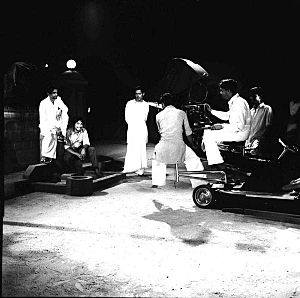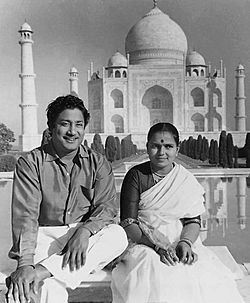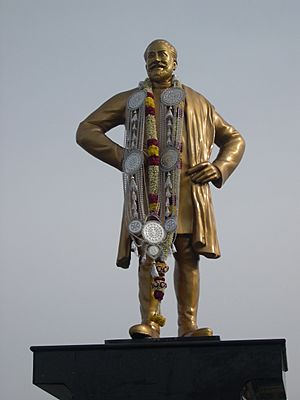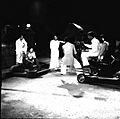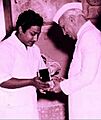Sivaji Ganesan facts for kids
Quick facts for kids
Sivaji Ganesan
|
|
|---|---|

Sivaji Ganesan
|
|
| Born |
Villupuram Chinnaiya Manrayar Ganesamoorthy
1 October 1928 |
| Died | 21 July 2001 (aged 72) Chennai, Tamil Nadu, India
|
| Other names | Nadigar Thilagam Simmakuralon |
| Years active | 1952–1999 |
| Political party |
|
| Spouse(s) |
Kamala
(m. 1952; |
| Children | 4, including Ramkumar and Prabhu |
| Parent(s) | Father : Chinnaiya Manrayar Mother : Rajamani Ammal |
| Relatives | Dushyanth Ramkumar (grandson) Vikram Prabhu (grandson) |
| Awards |
|
Sivaji Ganesan (born Villupuram Chinnaiya Manrayar Ganesamoorthy, October 1, 1928 – July 21, 2001) was a famous Indian actor and producer. He was a big star in Tamil movies during the second half of the 1900s. Many people say he was one of the greatest Indian actors ever, and many other actors learned from him.
Sivaji Ganesan was known for playing many different kinds of roles. This earned him the Tamil nickname Nadigar Thilagam, which means "the pride of actors". In his career, which lasted almost 50 years, he acted in 288 films. These movies were in Tamil, Telugu, Kannada, Malayalam, and Hindi languages. He was the only Tamil actor to play the main role in over 250 films.
Ganesan was the first Indian actor to win a "Best Actor" award at an international film festival. This was at the Afro-Asian Film Festival in Cairo, Egypt, in 1960. Many top actors in South India have said that Sivaji Ganesan influenced their acting. In 1997, he received the Dadasaheb Phalke Award, which is the highest honor for films in India. He was also the first Indian actor to be made a Chevalier of the Ordre des Arts et des Lettres by the French government. He also won a National Film Award, four Filmfare Awards South, and three Tamil Nadu State Film Awards.
Sivaji Ganesan is remembered as a huge icon in Tamil cinema. When he passed away, the Los Angeles Times newspaper called him "the Marlon Brando of south India's film industry".
Contents
Early Life and Stage Acting
Sivaji Ganesan was born on October 1, 1928, in Villupuram, India. He was the fourth son of Chinnaiya Manrayar and Rajamani Ammal. Early in his career, he used the name V. C. Ganesan. Some say 'V' stood for Villupuram, but one of his sons said it was for Vettaithidal, his family's village.
When he was just seven years old, Ganesan decided to join a traveling drama company. He did this without his father's permission. At age 10, he moved to Tiruchirappalli and joined another drama group. There, he started performing in stage plays. He was lucky to learn acting and dancing from the trainers. He was taught Bharatanatyam, Kathak, and Manipuri dance styles.
Ganesan was very good at remembering long lines easily. The drama group often chose him for lead roles. He became known as "Sivaji" after playing Shivaji in the play Shivaji Kanda Hindu Rajyam. This name was given to him at a public event by social reformer Periyar. From then on, everyone called him "Sivaji".
Film Career Highlights
Starting Out in Movies: 1952–1959
Ganesan made his movie debut in 1952 in the Tamil film Parasakthi. It was directed by the Krishnan–Panju duo and also starred actress Pandari Bai. The film was a huge hit right away. It played for over 175 days in many theaters. It also ran for more than 50 days in all 62 places it was released. In Sri Lanka, it played for nearly 40 weeks.
A film distributor named P. A. Perumal Mudaliar was impressed by Ganesan's acting. He had seen Ganesan play Nur Jahan in a stage play. So, Perumal decided to cast him in Parasakthi. In 1950, he even gave Ganesan a flight ticket to Madras for the screen test. Ganesan had also filmed for a Telugu-Tamil movie called Paradesi / Poongothai. This movie was supposed to be released first. However, Perumal asked the co-producer to let Parasakthi come out first, and she agreed.
The start of Parasakthi was not easy for Ganesan. After 2000 feet of film were shot, A. V. Meiyappan, a producer, thought Ganesan was too thin. He wanted to replace him with K. R. Ramasamy. But Perumal refused, and Ganesan stayed. Meiyappan was happy with the final movie. The scenes he disliked were re-shot. Ganesan was paid 250 Indian Rupees a month for the film. The script was written by M. Karunanidhi, who later became the Chief Minister of Tamil Nadu.
Ganesan became very popular in Tamil cinema in the 1950s. This was because he was trained in classical dance. This helped him show many different emotions on his face. His unique voice was also very appealing. He was known for delivering long dialogues like poetry, with great clarity. This earned him much praise.
Two main reasons helped Ganesan become a film star. First, many main actors in Tamil films during the 1940s and 1950s were from Telugu-speaking areas. Their acting was good, but their Tamil dialogue delivery was not always perfect. Second, the 1950s saw the rise of the Dravidian movement in Tamil Nadu. Leaders like C. N. Annadurai and M. Karunanidhi wrote powerful scripts. Ganesan's ability to deliver these lines perfectly made him a natural fit.
Andha Naal (1954) was a special film in Tamil cinema. It had no songs, and Ganesan played a character who was not a hero. The film won a special award from the President the next year. In the same year, he acted with his rival M. G. Ramachandran in Koondukkili. In this movie, Ganesan played the bad guy.
Playing Many Roles: 1954–1968
His role in the film Veerapandiya Kattabomman won him the Best Actor Award. This was at the Afro-Asian Film Festival in Cairo in March 1960. Ganesan was the first Indian actor to win a Best Actor award abroad.
Pasamalar is often seen as a very important film in Tamil cinema. It is one of the best movies starring Sivaji Ganesan and Savitri together. Directed by A Bhimsingh, this film has a huge fan following. When it was released in 1961, it became a trendsetter and made a lot of money. After its release, many films with similar themes were made. It also won a National Award that year and was remade in several languages.
Uthama Puthiran (1958) was the first film where Ganesan played two different roles. It was also the first Indian film to use the zoom technique for shots.
Sivaji Ganesan acted in many successful Tamil movies with popular actresses. Some of his hit films include Palum Pazhamum, Irumbu Thirai, Padikkadha Medhai, Paava Mannippu, Padithal Mattum Podhuma, Aalayamani, Iruvar Ullam, and Annai Illam. He also starred in Aandavan Kattalai, Kappalottiya Thamizhan, Mahabharata (1965), Kai Koduttha Dheivam, and Puthiya Paravai. His 100th film, Navarathri, was very special. In this movie, Ganesan played nine different roles. Many consider it one of his best films, showing his amazing acting talent.
He also played funny roles in several movies. These include Kalyanam Panniyum Brahmachari (1954), Sabaash Meena (1958), Ooty Varai Uravu (1967), and Galatta Kalyanam (1968).
Historical and Mythological Roles: 1965–1969
His role as Lord Shiva in the movie Thiruvilayadal (1965) brought him much praise. Ganesan was able to balance acting in popular movies, mythological films, and experimental films. His epic roles in movies like Thiruvilayaadal, Thiruvarutselvar, Saraswati Sabatham, Thirumal Perumai, and Thillana Mohanambal were highly praised.
He played many different types of characters. These included freedom fighters like Tiruppur Kumaran and Bhagat Singh. He also played epic characters like Karna, Bharatha, Narada, Appar, Nayanmars, and Alwars. Ganesan acted in all kinds of movies, from epic stories to crime thrillers, romantic comedies, and action films.
Superstardom and Later Career: 1970–1999
In the 1960s and 1970s, his films were very popular, and he had many constant hits. Some of his famous movies from this time are Vasantha Maligai, Gauravam, Thanga Pathakkam, and Sathyam. Many of his films inspired remakes in the Sinhalese language. Movies like Pilot Premnath and Mohana Punnagai were filmed in Sri Lanka. They featured Sri Lankan actresses like Malini Fonseka and Geetha Kumarasinghe as the female leads.
In 1979, he starred in Thirisoolam, which was his 200th film and a huge blockbuster. It was based on the Kannada film Shankar Guru.
Muthal Mariyathai (1985) won him a Filmfare Award and a Tamil Nadu State Film Award for Best Actor. In the 1990s, Ganesan started playing more mature roles. In 1992, he acted with Kamal Haasan in the acclaimed film Thevar Magan. This movie won him a Special Mention Award at the 40th National Film Awards. Other films he made during this time include Pasumpon, Once More, En Aasai Rasave, and Mannavaru Chinnavaru. He also acted with Mohanlal in the movie Oru Yathramozhi (1997). His last film released before his death was Pooparika Varugirom. However, the last film he worked on was Padayappa (1999).
Mentor and Philanthropy
Chinna Ponnusamy Padayatchi was the theater teacher who trained Ganesan. Ganesan once said that theater taught him everything. His teacher taught him Bharatnatyam, acting, and body movements. He learned in a place that felt like a special school.
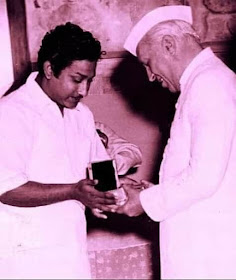
Sivaji Ganesan gave a lot of money to help people during natural disasters and for education. In 1960, K. Kamaraj started the Midday Meal Scheme for children. Sivaji Ganesan donated one lakh rupees (a large sum of money) to this program. He also gave a gold chain to P. Kakkan, who was living in poverty. He donated all the money from his play 'Thanga Padhakkam' to charity. He also gave a large amount of money during the Indo-Pakistani War of 1965.
Sivaji Ganesan bought the place where Veerapandiya Kattabomman was hanged in Kayatharu. He then put up a statue of Veerapandiya Kattabomman there, which is still a monument today. He also donated elephants to many temples, like the Venkateswara Temple and Brihadisvara Temple, Thanjavur.
Political Journey
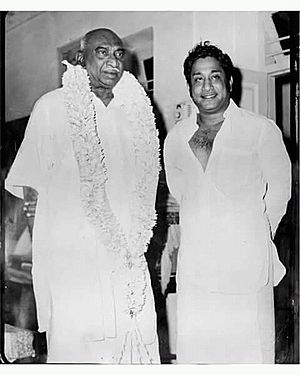
Ganesan started his political journey as an activist for the Dravidar Kazhagam party. He then joined the Dravida Munnetra Kazhagam (DMK) when it was started in 1949. Until 1956, Ganesan was a strong supporter of the DMK. However, he was criticized for visiting a temple, which went against the party's ideas. He left the DMK and joined the Tamil National Party. This party later became part of the Indian National Congress. He greatly respected Congress leader K. Kamaraj and supported his leadership.
In 1962, Ganesan became a strong supporter of the Indian National Congress. Because he was so popular, he was asked to join the National Congress in Tamil Nadu. His respect for Kamaraj made him support the party. He was made a Rajya Sabha Member of Parliament by the Prime Minister at that time, Indira Gandhi. After Indira Gandhi's death in 1984, Ganesan's political career also ended.
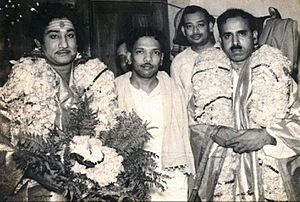
After the death of M. G. Ramachandran, the leader of the AIADMK party, in 1987, the party split. Sivaji Ganesan disagreed with the Tamil Nadu Congress's decision to ally with one part of the AIADMK. So, he left the party with his supporters. He formed his own new party called Thamizhaga Munnetra Munnani on February 10, 1988. To make his party popular, Ganesan produced a movie called En Thamizh En Makkal (My Tamil language and my people). In the 1989 elections, his party lost all its seats. Sivaji himself lost his election in the Tiruvayaru area.
He later joined the Janata Dal party under V. P. Singh. He became the state president of that party. However, his political career ended in 1993.
Political Parties He Joined
| S.No | Party's Leader | Party's | Year's Active |
|---|---|---|---|
| 1 | Periyar E. V. Ramasamy | Dravidar Kazhagam | (1944–1949) |
| 2 | C. N. Annadurai | Dravida Munnetra Kazhagam | (1949–1956) |
| 3 | E. V. K. Sampath | Tamil National Party | (1961–1964) |
| 4 | Kamarajar/Jawaharlal Nehru/Gulzarilal Nanda/Lal Bahadur Shastri/Indira Gandhi/Rajiv Gandhi | Indian National Congress | (1964–1969) & (1977–1988) |
| 5 | Kamarajar | Congress (O) | (1969–1977) |
| 6 | Sivaji Ganesan (Own Party) | Thamizhaga Munnetra Munnani | (1988–1989) |
| 7 | V. P. Singh | Janata Dal | (1989–1993) |
Family Life
Ganesan was the fourth son in his family. He had three brothers and one sister. He married Kamala on May 1, 1952. They had four children together. His younger son, Prabhu, is also a well-known Tamil actor.
In the late 1950s, Ganesan started a film production company. It is now called Sivaji Productions and is managed by his elder son, Ramkumar. He also had two daughters named Shanthi and Thenmozhi. Two of his grandsons, Vikram Prabhu and Dushyant Ramkumar, have also become actors. Vikram Prabhu, Prabhu's son, made his debut in the movie Kumki in 2012.
Passing Away
Sivaji Ganesan had breathing problems and a heart condition for about 10 years. He was admitted to the Apollo Hospital in Chennai on July 1, 2001. He passed away on July 21, 2001, at 7:45 PM (IST). He was 72 years old, just three months before his 73rd birthday. A documentary called Parasakthi Muthal Padayappa Varai was made to honor his life and work.
He was given a State funeral, which is a special public funeral. His funeral the next day was shown live on Sun TV. Thousands of people, including politicians and film stars, attended. His son, Ramkumar, performed his last rites at the Besant Nagar Crematorium in Chennai.
International Recognition
When President Gamal Abdel Nasser of Egypt visited India, Sivaji Ganesan was the only person allowed to host a party for him. This permission came from the Indian Prime Minister at the time, Jawaharlal Nehru. Ganesan gave Nasser many valuable gifts that showed the culture of South India.
Sivaji Ganesan was the first Indian artist to visit the United States. This was part of a cultural exchange program by the U.S. government in 1962. He was invited by the President, John F. Kennedy, and acted as India's cultural ambassador. During his visit, he was made the honorary mayor of Niagara Falls, New York for one day. He was also given the golden key to the city. The only other Indian to receive this honor before Ganesan was Jawaharlal Nehru. When Sivaji returned from America, a huge crowd, including M. G. Ramachandran, greeted him at the Madras Airport. When he returned from Egypt after winning the best actor award, another huge crowd welcomed him.
On March 22, 1976, he visited Mauritius after being invited by Prime Minister Ramagoolam. He took part in their independence day celebrations and stayed as a government guest for four days.
During his visit to the United States in June 1995, he went to Columbus, Ohio. The Mayor of Columbus, Greg Lashutka, honored him by making him an honorary citizen of the city. The Mayor of Mount Vernon also gave him a special welcome. The Columbus Tamil Sangam (a Tamil association) was formed that day, and Ganesan was made its honorary President.
Even though Sivaji played fewer main roles after the 1980s, his supporting roles were still very well-received. For example, in Thevar Magan, he won a National Awards Special Jury award in 1993. Interestingly, Sivaji turned down this award.
His Acting Style
Sivaji Ganesan is thought to be one of the best Indian actors ever. He was also known as one of the most copied actors. People praised his body language, his powerful voice, and how he delivered dialogues. Ganesan was famous for his ability to play many different roles.
He acted as a blind man in Palum Pazhamum and a physically challenged person in Bhaaga Pirivinai. In "Navarathiri", he played nine completely different characters from various walks of life. He changed his body language, voice, and facial expressions for each role. This made him possibly the first actor in Indian cinema history to play nine roles in one film. This inspired later films in Tamil, like "Navarathinam" and "Dasavatharam". He also played a man with a scarred face in Deiva Magan, a murderer in Pudhiya Paravai, and a traitor in Andha Naal. Andha Naal was also the first movie that had no songs at all.
On October 1, 2021, Google honored Ganesan's 93rd birthday with a Google Doodle on their Indian homepage.
Important Films
Here are some of Sivaji Ganesan's most famous and successful films:
- Parasakthi (1952) - His first film
- Antha Naal (1954)
- Manohara (1954)
- Uthama Puthiran (1958)
- Veerapandiya Kattabomman (1959)
- Pasamalar (1961)
- Palum Pazhamum (1961)
- Karnan (1964)
- Navarathri (1964) - His 100th Movie
- Thiruvilaiyadal (1965)
- Thillana Mohanambal (1968)
- Uyarndha Manithan (1968) - His 125th Movie
- Deiva Magan (1969)
- Vasantha Maligai (1972)
- Gowravam (1973)
- Thanga Pathakkam (1974)
- Thirisoolam (1979) - His 200th Movie
- Muthal Mariyathai (1985)
- Thevar Magan (1992)
- Padayappa (1999)
Awards and Honors
National and International Civilian Honors
| Year | Award | Honoring Body | Outcome | Ref |
|---|---|---|---|---|
| 1966 | Padma Shri | Government of India | Won | |
| 1984 | Padma Bhushan | Government of India | Won | |
| 1995 | Chevalier | Government of France | Won |
International Awards
| Year | Award | Film | Outcome | Ref |
|---|---|---|---|---|
| 1960 | Best Actor in Asia | Veerapandiya Kattabomman | Won |
National Film Awards
| Year | Award | Film | Outcome | Ref |
|---|---|---|---|---|
| 1992 | National Film Award – Special Jury Award | Thevar Magan | Won | ' |
| 1996 | Dadasaheb Phalke Award | Won |
Filmfare Awards South
| Year | Award | Film | Outcome | Ref |
|---|---|---|---|---|
| 1972 | Filmfare Best Tamil Actor Award | Gnana Oli | Won | |
| 1973 | Filmfare Best Tamil Actor Award | Gauravam | Won | ' |
| 1985 | Filmfare Best Tamil Actor Award | Muthal Mariyathai | Won | ' |
| 1985 | Filmfare Lifetime Achievement Award – South | Won |
Tamil Nadu State Film Awards
| Year | Award | Film | Outcome | Ref |
|---|---|---|---|---|
| 1969 | Tamil Nadu State Film Award for Best Actor | Deiva Magan | Won | |
| 1970 | Tamil Nadu State Film Award for Best Film | Vietnam Veedu | Won | |
| 1989 | Tamil Nadu State Film Honorary Award | MGR Award | Won |
Other Honors
| Year | Award | Honoring Body | Outcome | Ref |
|---|---|---|---|---|
| 1986 | Honorary doctorate | Annamalai University | Won | |
| 1962 | Kalaimamani | Government of Tamil Nadu | Won | |
| 1998 | NTR National Award | Government of Andhra Pradesh | Won |
Posthumous Honors
Pondicherry (Puducherry) was the first state to build a statue of Sivaji Ganesan. This was done to honor his acting skills and his many fans there. The statue was revealed by the Chief Minister of Puducherry, N. Rangasamy. A statue of Ganesan was also put up on Kamarajar Road in Chennai, Tamil Nadu. The Chief Minister of Tamil Nadu, M. Karunanidhi, revealed this statue in 2006.
Memorial
In 2017, a memorial was opened in Chennai. It cost 28 million Indian Rupees to build. The memorial is in Adyar, a southern part of the city. It is built in the Tamil style of architecture, with domes. It also has a statue of the actor, which was first put on the Marina Beach in 2006.
Images for kids
-
Sivaji Ganesan with Nehru
-
K. Kamaraj with Sivaji Ganesan
-
Sivaji Ganesan (far left) with M. Karunanidhi next to him.
See also
 In Spanish: Sivaji Ganesan para niños
In Spanish: Sivaji Ganesan para niños



